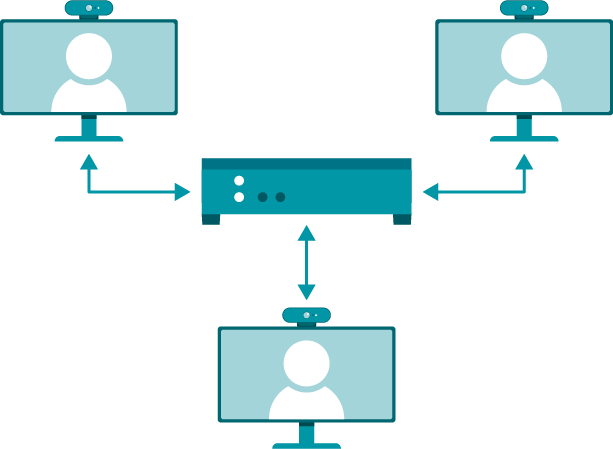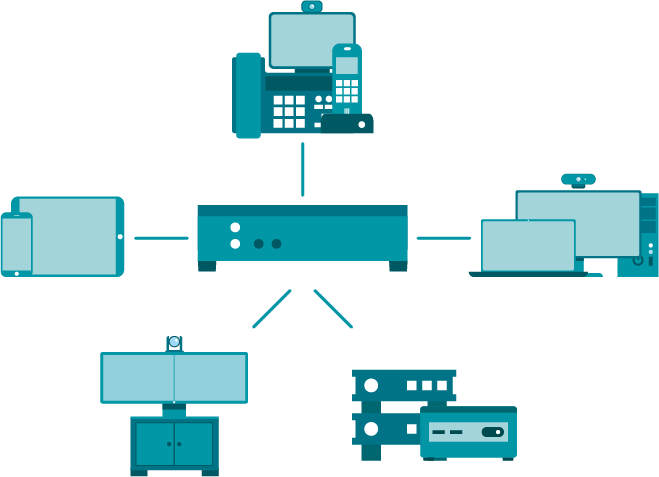From The Hardware Past To The Software Future
A video transcoding server, better known as a multipoint control unit (MCU), is the core element of any video conferencing system. It connects all users of a video conferencing system within a single network and provides a wide range of functions. In fact, it is the MCU that defines any video conferencing system — not only basic parameters, such as data security, stability, video, and sound quality, but also a number of additional options that turn ordinary video communication into an efficient business communication tool. The server solves audio/video switching tasks, coordinates user devices and software, and interacts with an H.323 gatekeeper that manages calls and performs many other important functions.

In addition, the multipoint control unit takes care of mixing, transcoding, and transrating. Mixing allows selecting video layout that is convenient for all conference users. Transcoding helps change the video stream format, while transrating optimizes the data transfer rate. The MCU also affects the load on endpoints: the more it works, the fewer calculations are made by user devices (which in general make the latter more affordable). However, the simplest video server model provides only basic switching and mixing features. Of course, the MCU is not a cheap device — when you search for options, you’d rather walk a fine line between functionality and price. Relatively recently MCU deployment may have been way too complex; however, over the past five years it has become much easier to choose the most suitable system thanks to software development progress.
Hardware MCUs: Obstacles To Progress
For a long time, only hardware MCU models used to be available on the market. Those were RISC-based computing systems powered by Unix-like operating systems. As a rule, architectures were closed and exclusively supported by specific vendors who often made them incompatible with third-party endpoints. Of course, these servers were hardware in name only, since they contained software, but it was tied to a specific physical platform. That is exactly when video conferencing was first seen as an expensive tool. All in all, a closed (proprietary) architecture significantly limited user capabilities, as new functions to be implemented depended directly on how often both hardware and software components were updated by a vendor.
It is also important that these legacy MCUs were compatible with external devices only via traditional SIP and H.323 protocols. This led to additional restrictions, e.g. the number of conference participants who were simultaneously visible without cascading (connecting additional MCUs to the main server) couldn’t exceed 25. You also couldn’t use some popular features, such as chats, webinars, file sharing, collaboration tools, presence statuses, and mobile device support, since they couldn’t be implemented using SIP or H.323. Video conference recording, NAT traversal, adding telephony subscribers to conferences, and online streaming were available but didn’t go with a standard package for a hardware-software video server and required additional extensions.
Software Flexibility and Versatility
However, as technological progress enabled new developers to enter the market, and computational performance of standard architecture systems grew, we now see the current situation where software does not depend on hardware products made by a particular vendor and can run on any x86 server (or even a PC). This made it possible to deploy a full-fledged MCU on-prem or even in the cloud, paying only for certain software licenses. In addition, once powerful and affordable graphics processing units (GPUs) came into the mass market, specialized solutions became redundant. Gradually, all MCU vendors scrapped specialized hardware platforms and switched to standard hardware, enabling developers to use virtual machines for implementation of video conferencing features.

It should be noted that software MCUs not only provide wide functionality for efficient video conferencing systems but also allow using the most efficient cybersecurity options thanks to automatic installation of the latest patches according to a subscription plan as well.
Software makes video conferencing systems more flexible. In addition, you don’t have to buy unnecessary hardware components, thus getting a better final cost. As a result, software video transcoding server is by now the best option that turns a video conference from a luxury whim into a widely accessible tool for private and business communication.